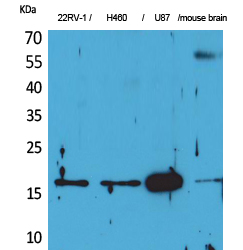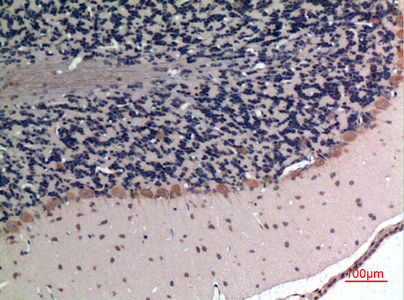Apelin Polyclonal Antibody
- SPECIFICATION
- CITATIONS
- PROTOCOLS
- BACKGROUND

Application
| WB, IHC-P |
|---|---|
| Primary Accession | Q9ULZ1 |
| Reactivity | Human, Mouse, Rat |
| Host | Rabbit |
| Clonality | Polyclonal |
| Calculated MW | 8569 Da |
| Gene ID | 8862 |
|---|---|
| Other Names | APLN; APEL; Apelin; APJ endogenous ligand |
| Dilution | WB~~Western Blot: 1/500 - 1/2000. IHC-p: 1:100-300 ELISA: 1/20000. Not yet tested in other applications. IHC-P~~N/A |
| Format | Liquid in PBS containing 50% glycerol, 0.5% BSA and 0.09% (W/V) sodium azide. |
| Storage Conditions | -20℃ |
| Name | APLN (HGNC:16665) |
|---|---|
| Synonyms | APEL |
| Function | Peptide hormone that functions as endogenous ligand for the G-protein-coupled apelin receptor (APLNR/APJ), that plays a role in cadiovascular homeostasis (PubMed:10525157, PubMed:22810587, PubMed:35817871, PubMed:38428423). Functions as a balanced agonist activating both G(i) protein pathway and beta-arrestin pathway of APLNR (PubMed:22810587, PubMed:38428423). Downstream G proteins activation, apelin can inhibit cAMP production and activate key intracellular effectors such as ERKs (PubMed:22810587, PubMed:35817871, PubMed:38428423). On the other hand, APLNR activation induces beta- arrestin recruitment to the membrane leading to desensitization and internalization of the receptor (PubMed:22810587, PubMed:38428423). Apelin blunts cardiac hypertrophic induction from APLNR on response to pathological stimuli, but also induces myocardial hypertrophy under normal conditions (PubMed:22810587, PubMed:38428423). Apelin-36 dissociates more hardly than (pyroglu)apelin-13 from APLNR (By similarity). Involved in the regulation of cardiac precursor cell movements during gastrulation and heart morphogenesis (By similarity). Has an inhibitory effect on cytokine production in response to T-cell receptor/CD3 cross-linking; the oral intake of apelin in the colostrum and the milk might therefore modulate immune responses in neonates (By similarity). Plays a role in early coronary blood vessels formation (By similarity). Mediates myocardial contractility in an ERK1/2-dependent manner (By similarity). May also have a role in the central control of body fluid homeostasis by influencing vasopressin release and drinking behavior (By similarity). |
| Cellular Location | Secreted {ECO:0000250|UniProtKB:Q9TUI9}. Secreted, extracellular space. Note=Abundantly secreted in the colostrum. Lower level in milk. Decreases rapidly within several days after parturition in milk, but is still detectable even in commercial milk. {ECO:0000250|UniProtKB:Q9TUI9} |
| Tissue Location | Expressed in the brain with highest levels in the frontal cortex, thalamus, hypothalamus and midbrain (PubMed:10617103) Secreted by the mammary gland into the colostrum and the milk |

Thousands of laboratories across the world have published research that depended on the performance of antibodies from Abcepta to advance their research. Check out links to articles that cite our products in major peer-reviewed journals, organized by research category.
info@abcepta.com, and receive a free "I Love Antibodies" mug.
Provided below are standard protocols that you may find useful for product applications.
Background
Endogenous ligand for the apelin receptor (APLNR) (PubMed:10525157). Drives internalization of the apelin receptor (By similarity). Apelin-36 dissociates more hardly than (pyroglu)apelin-13 from APLNR (By similarity). Hormone involved in the regulation of cardiac precursor cell movements during gastrulation and heart morphogenesis (By similarity). Has an inhibitory effect on cytokine production in response to T-cell receptor/CD3 cross-linking; the oral intake of apelin in the colostrum and the milk might therefore modulate immune responses in neonates (By similarity). Plays a role in early coronary blood vessels formation (By similarity). Mediates myocardial contractility in an ERK1/2-dependent manner (By similarity). May also have a role in the central control of body fluid homeostasis by influencing vasopressin release and drinking behavior (By similarity).
If you have used an Abcepta product and would like to share how it has performed, please click on the "Submit Review" button and provide the requested information. Our staff will examine and post your review and contact you if needed.
If you have any additional inquiries please email technical services at tech@abcepta.com.













 Foundational characteristics of cancer include proliferation, angiogenesis, migration, evasion of apoptosis, and cellular immortality. Find key markers for these cellular processes and antibodies to detect them.
Foundational characteristics of cancer include proliferation, angiogenesis, migration, evasion of apoptosis, and cellular immortality. Find key markers for these cellular processes and antibodies to detect them. The SUMOplot™ Analysis Program predicts and scores sumoylation sites in your protein. SUMOylation is a post-translational modification involved in various cellular processes, such as nuclear-cytosolic transport, transcriptional regulation, apoptosis, protein stability, response to stress, and progression through the cell cycle.
The SUMOplot™ Analysis Program predicts and scores sumoylation sites in your protein. SUMOylation is a post-translational modification involved in various cellular processes, such as nuclear-cytosolic transport, transcriptional regulation, apoptosis, protein stability, response to stress, and progression through the cell cycle. The Autophagy Receptor Motif Plotter predicts and scores autophagy receptor binding sites in your protein. Identifying proteins connected to this pathway is critical to understanding the role of autophagy in physiological as well as pathological processes such as development, differentiation, neurodegenerative diseases, stress, infection, and cancer.
The Autophagy Receptor Motif Plotter predicts and scores autophagy receptor binding sites in your protein. Identifying proteins connected to this pathway is critical to understanding the role of autophagy in physiological as well as pathological processes such as development, differentiation, neurodegenerative diseases, stress, infection, and cancer.

.jpg)
.jpg)


